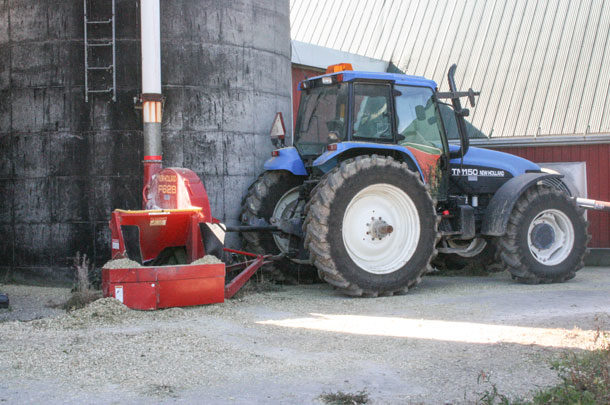Looking at the 462 hybrids across all companies in the Pioneer silage trials in Ontario, silage tonnage was down by 2.4 tons per acre (at 35 percent dry matter), and starch was down 1.4 percent from the 2015 silage trials. There was a significant spread between the highest and lowest yielding hybrids – 34 tons per acre and 51 percent starch (not the same hybrid) were the winning values, and rounding out the bottom were hybrids producing 7 tons per acre and 12 percent starch. The key determining factor was whether or not the locations received timely rains. If we examine 2016 more closely, we can see what was experienced in the five main phases of growing corn for silage (plant, grow, harvest, store and feed) and see what key learnings we can take from each.
Plant
An agronomic principle that is almost as old as the corn plant itself is to plant corn at least 1.5 inches deep. The corn seed needs to be at least 1.5 to 2 inches deep to ensure adequate moisture uptake and seed-to-soil contact, which allows for a more uniform emergence. Deeper planting is recommended as the season progresses and soils become drier, which is what we experienced in certain parts of the province last spring. Planting shallower than 1.5 inches is not recommended at any planting date or in any soil type. Such excessively shallow planting can cause uneven emergence due to soil moisture variation and rootless corn later in the season when hot, dry weather inhibits nodal root development. Even emergence plays a major role in overall grain yields (Figure 1). A Pioneer study in collaboration with the Ohio State University showed the value of making sure the planter is set deep enough.

Learnings from 2016: Plant into moisture. If the moisture is 3 inches deep, that is where the seed needs to be planted.
Grow
Most parts of the province experienced drought during some point this past summer, with certain areas getting hit harder than others. Water is vital for plant development; nutrients such as nitrogen use water as its transportation source into the corn plant. This may help explain why we saw nitrogen deficiency in fields that had sufficient nitrogen application. Depending on the growth stage of the plant, duration of the drought and a hybrid’s ability to withstand dry conditions, drought stress will affect corn yields.
Corn has the highest demand for water during pollination (Table 1). If the plant experiences drought during this time, it will have the largest impact on yield. Luckily most of the province was not under severe stress at this time, so adequate pollination occurred. However, in areas where drought continued, corn plants started to abort the kernels, starting from the tip and working towards the base of the cob. This was a very common sight across many areas. A general rule of thumb is for every aborted row around the cob, five to six bushels were lost.

Learnings from 2016: Planting a package of varying maturities helps spread out the time period for the critical pollination phase.
Harvest
Determining timing of corn silage harvest should be based on milk line (at least half milk line) and, secondarily, whole plant moisture. Starch (energy), a main reason for feeding corn silage, increases as the milk line progresses down the kernel. Chopping before the kernel reaches half milk line will reduce starch levels and also whole plant moistures tend to be higher than desired, risking undesirable fermentation and leaching. This fall, we observed two different scenarios around harvest:
1. Severely drought-stressed corn with few cobs present
Early in the season (late July), the corn plant already looked very dry with dead leaves, but there was still significant moisture retained in the stalks, as shown in Figure 2. Leaves only make up 10 percent of the whole plant, whereas the stalk makes up 25 percent. Kernel development is a key part in reducing whole plant dry matter, so with little to no cobs present, the corn took longer to dry down than one may have thought.

Testing moisture with a proven technique was very critical this fall to ensure proper silage harvest moisture. In drought conditions, harvest still needs to take place at the moistures suitable for the storage structure, like any other year, to ensure proper ensiling.
2. Corn not under severe drought stress with cobs present
Whole plant corn moistures were testing drier than what appeared to the eye. Grain maturity advanced more quickly due to the weather conditions, relative to stalks and leaves turning brown. The corn ear makes up 60 percent of the corn plant dry matter, so the drier the kernels are, the lower the whole plant moisture. When silage is put in too dry for the specific structure, it is hard to have efficient fermentation as it is very difficult to remove all the air. With air present, yeast and mold growth begins, resulting in increased spoilage (even with the use of an inoculant).
Learnings from 2016: Looks can be deceiving. Monitoring milk line first, then checking whole plant moistures is key.
Store
Fall 2016 brought many warm days, which helped make corn silage harvest a little less stressful. Some producers were finding their silage still felt warm one to two months post-harvest. Does this mean we have a heating issue? Heat is produced during fermentation, and this heat will take a while to leave the silage as the air is “trapped” in the structure. This is called physiological heating, and it will cool down over time. If silage was harvested when it was 24ºC outside and is undergoing fermentation, the silage temperature could peak at 34ºC. Corn silage is a great insulator compared with hay crop silages and thus takes extra time to get rid of this heat.
When air penetrates into silage, yeast and molds may begin to grow, which will cause unwanted heating in silage and spoil the feed. We want to avoid this unnecessary heating from spoilage by ensuring great storage management, accurate feedout rates, etc.
If silage is “heating,” producers should find out if it is physiological heat or heat from spoilage. A quick test is to grab a sample fresh from storage, measure the temperature and leave it exposed to air for three to four hours before remeasuring the temperature. If the silage sample has cooled down, it was physiological heat. If the silage temperature increased, then there is a heating issue, and further investigation into the cause of heating should be conducted. A feed sample can be sent for a fermentation analysis, yeast and bacillus count, as well as completion of an analysis of storage management practices.
Learnings from 2016: If the silage is heating, is it physiological heat or is there a spoilage heating issue?
Feed
Certain areas experienced relatively high levels of mycotoxins this past year. Field molds produced these mycotoxins due to spores that entered the plant through silks, damaged kernels or plants throughout the growing season. One of the field molds, Gibberella ear rot (Gibb), produces three main mycotoxins: DON (vomitoxin), zearalenone and T-2. Weather conditions affect which mycotoxins Gibb will produce. During warm days, cool nights and late morning dew, Gibb will produce primarily DON and secondarily zearalenone. As the days get cooler and dampness continues, Gibb will produce the T-2 toxin.
Some areas have been seeing higher T-2 levels than in the past; the recommendation of maximum concentration in a total ration is 0.5 parts per million (ppm). Luckily, this toxin is of low risk to affect a dairy herd; very few cases have ever been reported. Higher insect damage due to western bean cutworm in particular and the weather conditions this year led to higher mycotoxin levels in certain areas.
Learnings from 2016: Growing a hybrid with built-in insect protection and a high Gibb tolerance can help reduce levels of mycotoxins produced. ![]()

-
Martina Pfister
- Dairy Specialist
- DuPont Pioneer
- Email Martina Pfister
PHOTO: Putting up corn silage was only part of the battle this year in drought-stricken parts of Canada. Photo by Karen Lee.










